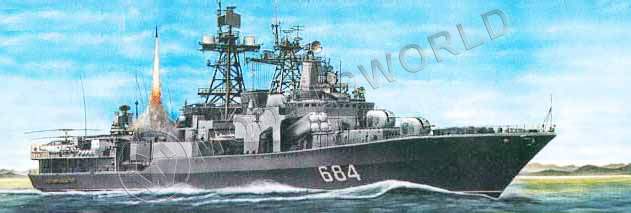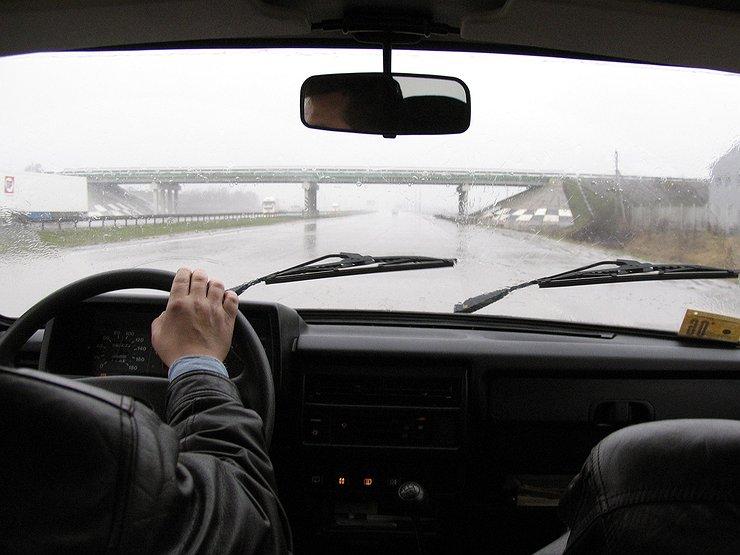
floating model
We can use our stay by the water and free time by playing with the homemade floating model. The toy has a drive, obtained due to the energy of twisted rubber. It moves smoothly through the waves on three floating floats and looks like ... nothing, but really modern in form. See for yourself (1) …
The most important thing in the model is that it will be made from recycled materials, waste, which means it will be eco. Its implementation will not take much time, and the necessary tools are probably already in our home workshop. Materials can be found in the plastic trash can and in the kitchen.
It is known that in stores you can buy a variety of floating models powered by lithium-ion batteries and radio control. The question is, why build a primitive model yourself? Well, it's worth it. By creating a toy with our own hands, our manual skills will increase, we will learn how to use tools and learn the properties of glues, especially hot glues. Building a working model will make us realize how strong a lattice made of fragile skewers and toothpicks is. We will also see how much energy can be stored in a twisted rubber band.
4. Stick the paper templates on the plastic.
5. Cut out the plastic reinforcement with scissors.
So, if we find the raw materials and supplies needed for construction, I suggest you get to work immediately.
Materials: skewers, a piece of thin stick, toothpicks, a hard plastic box such as ice cream, a thin tube from a ballpoint pen, thick cardboard or a postcard. In addition, you will need a clear piece of a plastic soda bottle, a rubber band that is used to tie vegetables in vegetable stores or at the market, a few paper clips, and a piece of Styrofoam as material for the floats.
6. Hull truss connection
7. This is how the bolt should be bent
Tools: dremel, hot glue gun, pliers, small front tongs, scissors, paper glue stick.
Model body. Let's make it in the form of a lattice of sticks glued together from skewers and toothpicks (6). The body needs to be strong as it will transmit the forces coming from the twisted rubber that propels the model. Therefore, it was designed in the form of farms.
We will start by drawing a diagram of the trusses on paper (2). This will make it easier for us to maintain the correct angles and proportions. On fig. Figure 1 shows the scale in centimeters, but to be sure, let's assume that the longest truss element drawn is the length of our skewer sticks.
To glue the frames, I suggest using hot glue supplied from a glue gun. Such glue, before it cools down, gives us some time to position the elements to be glued against each other. Then it hardens, and we do not have to wait long for a lasting effect. The adhesive holds firmly, while providing high stability even when the glued elements do not fit snugly together. Glue can be molded with a wet finger while it is still warm. It will take some practice to avoid burns. When the gun is warm, first stick two sticks parallel to each other. Then we glue these two pairs together from one end, adding a stick on the other side, making a triangle out of them. This can be seen in photo 3. Thus, we get a solid frame of the model structure. In the same way we make the second frame. As for the rest of the farms, we will supplement them with chopped toothpick sticks. These sticks, glued to the inside of the triangles, reinforce the structure. When working, it is good to use tweezers or small pliers to bend the wire.
8. The cardan shaft is bent from a paper clip;
9. Cutting floats from polystyrene
Rear spar. We will cut according to the scheme, from hard plastic (4). We will do the same with the amplifiers that fasten this element to the fuselage trusses (5). If this element turns out to be too sluggish, we strengthen the run with a wooden stick.
Salon frame. We will cut according to the scheme, from hard plastic into two identical elements. Let's start with the boards, which we will glue on both sides of the frames of the glued trusses. These are important elements as they reinforce the connection of the truss frames. Glue the semicircular elements shown in Fig. 1 at right angles to the plastic fittings; the roof of the car cabin will rest on them.
11. Front float will turn
Cabin cover. We will make the front of the lid from transparent plastic obtained from a soda bottle. Let's cut them out in the shape shown in Fig. 1. We need two identical parts. The back is cut out of cardboard. The cut element is glued to the top of the frame, and then shaped, gradually glued to the frame. Since our model needs to float on water and be exposed to moisture, it needs to be protected from water. Let's do it with a colorless varnish, after assembling the case together.
Swims. Cut out three identical elements from foam or hardened polystyrene (9). If we didn't have access to these plastics, we could successfully make floats out of wine corks. Glue 10 mm tubes from the rod to the handle to the floats. Bend the handles with wire from straightened paper clips, as in photo 15. The floats will be hinged to the body of the model (11, 13, 17). This will allow you to overcome the waves more easily. On fig. 2 presents the idea of such attachment of floats.
13. Attaching the front float
Propeller. We will cut it out of plastic from a margarine box. This material can be bent without problems. The corresponding screw shape is shown in fig. 1. We will make the bends as shown in photo 7. In order for the blades to be bent evenly, use pliers.
Engine model. Bend two staples. The front of the engine is shaped like a crank ending in a hook. The crank is placed in a block of wood (16) drilled into it. First form the crank, then thread the wire through the hole in the block, and finally form the hook. Glue a few millimeters of tailor's pin to the front of the block. When the engine is running, it turns the propeller, not the front crank.
The rear part of the engine (18) consists of a screw and an axle bent from a wire clamp (8). The wire is bent into shape as shown in the picture and ends with a hook. The screw support is a tube from the cartridge to the pen. The tube is wrapped with wire (14), the ends of which are glued to a wooden block. Now we can firmly glue the finished elements to the model frame from both ends of the fuselage. Of course, we remember that the crank is in front and the propeller is at the back of the model.
14. Fastening and propeller support
Model assembly. Glue the rear spar and the corresponding reinforcements to the body. Glue the supports to the ends of the spar, on which the floats (12) will be hinged. On the one hand, we cover the cabin with a cardboard casing, and in front - with transparent elements that we cut out from a bottle with a drink (10). Glue the front float support to the frame. At this point, we can paint the model with a clear spray varnish.
Rice. 2. Attaching floats
Since paint fumes are harmful, paint should be applied outdoors. If this is not possible, open a window in the room where we plan to draw. It is good to cover the model with several layers of waterproof varnish. We do not paint the floats, because the varnish does not react well with polystyrene. Once the paint is dry, it's time to install the floats. Glue the propeller to the back of the model. We connect the drive wires with an elastic band of the appropriate length. It should be slightly stretched.
16. Crank and engine front
17. Swivel floats
A game. We can start testing with the engine. Gently and sensitively hold the bolt, twist the rubber band. Its energy, accumulated in this way, will be gradually released and, by rotating the propeller, will set the vehicle in motion. We will see with our own eyes what power is hidden in twisted rubber. We put the vehicle on the surface of the water. When the homemade model (19) starts majestically, it will certainly give us a lot of joy. As promised, it also turns out that during the construction process we learned a lot about materials and their sources and, of course, acquired new skills in manual labor. And we make good use of our time.
18. Rear of the engine
First, let's try our model in a bathtub, tub or shower tray (20). If everything is working properly, then in good and possibly calm weather, you can go for a walk to the surrounding pond. Let's try to choose a shore as little overgrown as possible and preferably sandy. The householders will surely rejoice at our departure and will not be able to reproach us for spending all our free time in the workshop. Well, except that in turn we will be suspected of catching Pokemon ...
20. First rehearsals in the bath
See also:

